An Exciting Discovery…
So I was sitting at my desk when AJ comes into the office obviously excited about something. While mowing the grass on the property he noticed something that none of us had previously; the mustang grapes that grow throughout the office grounds were fruiting. Upon a further look of the fence line and nearby trees we were astounded by the amounts of fruit that the vines were bearing. AJ and I immediately started coming up with a plan on how to harvest and process the daunting amount of grapes hanging out of the trees. The summer heat would not allow the already ripened grapes to remain much longer.
Our plan was to pick as many as we could reasonably from the ground, then in the following day or two, use ladders to pick the ones in the trees. It took three different ‘attacks’ but the result was worth it! All in all, I believe we picked somewhere in the neighborhood of 12-15 gallons of mustang grapes! To us this was a pretty incredible sight!
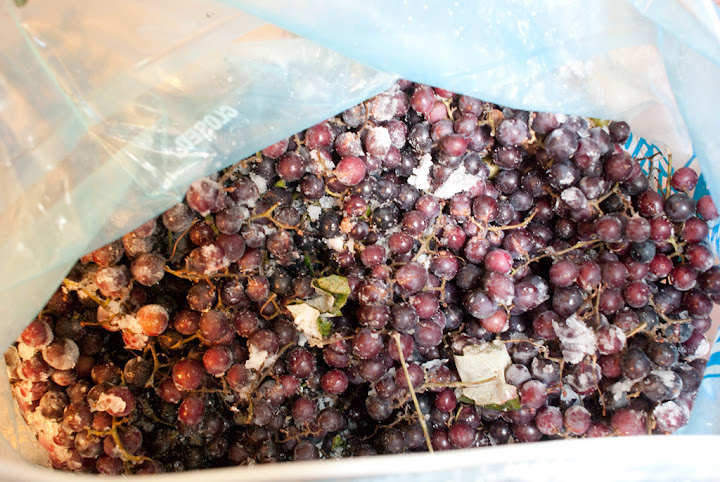
The first batch of picked grapes that we temporarily froze
Once off the vines, it was time to figure out what to do with all of the fruit! Mustang grapes are notoriously acidic and capable of burning skin (as Rebekah’s feet later found out). However, they make terrific jellies, jams and wine so we began the process of juicing and macerating our harvest. We decided to make mustang grape jelly, and some mustang wine.
Wine (all types, grape fruit etc.) was originally used as a way to allow juice to store for long periods of time without it spoiling and becoming dangerous to consume. Especially before the ability to sterilize and pasteurize, the natural yeasts on the skins of the fruits would start this process and if exposure to oxygen was minimized, a palatable end product would result. In biblical times they would allow the mix of crushed grapes and juice (called must) to sit in a large vat until eventually transferred to goat skins and sealed containers to minimize spoilage. Our goal with this wine was to bring up the alcohol content just to the point that we can bottle store and keep the wine for an extended period of time without it going bad or if we desire, we can convert it to red wine vinegar (essentially the careful spoiling of wine). Sauerkraut when made properly is actually a fermented product as well, and “keeps” for many of the same reasons that wine does.
The first step in this process was to crush the grapes and create a must. We did a lot of brainstorming but our eventually solution was to use a large metal bucket and crush them in that. The lovely Rebekah volunteered to be the grape crusher and so began the grape stomping process. I think most people are familiar with the classic image of people stomping grapes in a large pail. Well, it was a lot like that, however we learned a couple of things…
- Mustang grapes are VERY acidic and people should probably heed the warnings to wear rubber gloves.
- Burning from acidic grape juice will make Rebekah’s feet look sunburned
- Stomping previously frozen grapes will easily give you frost bite and you might as well give up
- Potato mashers are a huge help

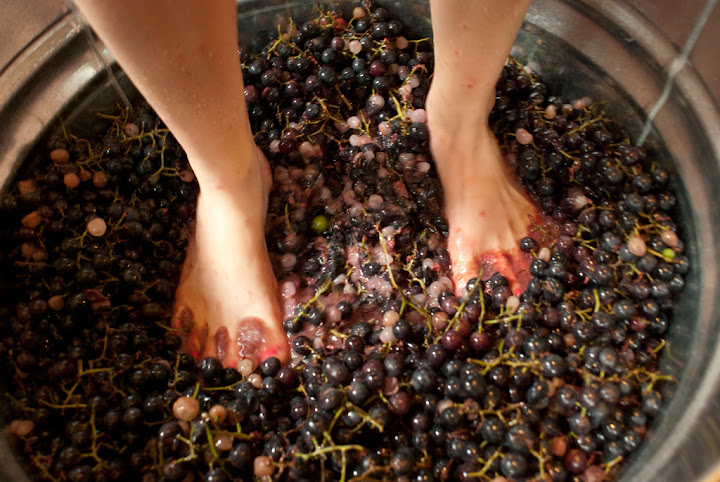
Rebekah stomping our grapes!
Once the grapes were turned into must, we put them all in the primary fermenting bucket. This is essentially a food grade plastic bucket with a sealed lid and an airlock. We added a little bit of sugar and yeast to help the process along due to the very low sugar content that mustangs have. Fermentation (pickles, sauerkraut, wine) is really interesting to me due to the mixed amount of sciences you use to create the end product. Its a dynamic mix of chemistry, physics and biology and definitely a challenge!
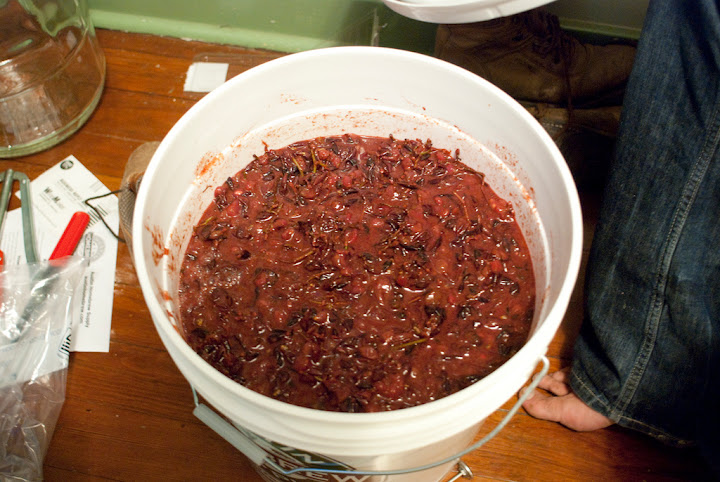
Must in the primary fermenter
After five days we strained and siphoned the must into the secondary container. This is where malo lactic fermentation occurs, making the juice taste better. We also added a bit more sugar and water at this phase. Specific gravity readings are used to determine approximate alcohol content which is an interesting thing in itself.
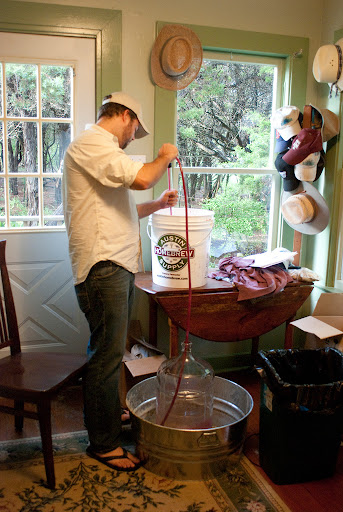
Kellan siphoning juice from the primary to the carboy on the ground
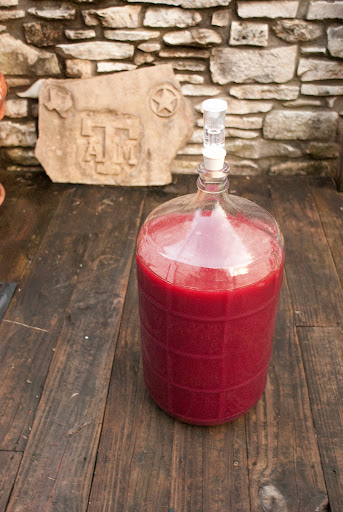
The end result of siphoning!
From this point on it is a waiting game. While I believe we’ve been doing things right, we wont know for another month or two. In that time we’ll probably re-rack the wine into a smaller container to allow it to age a bit longer and then eventually bottle everything! Ross (my Dad) and I have had numerous discussions on strategies over the course of the process. Given its our first attempt, who knows what will happen. In a week’s time it has already cleared considerably and gotten darker so fingers crossed! ![]()
Meanwhile, Rebekah and I also decided to work on making some mustang jelly so we picked more grapes and mashed them with a potato masher then strained the mash through a cheese cloth to remove as much of the solids as possible. For jellies to keep, you have to pasteurize everything to prevent bacteria from forming. We added sugar to our raw juice and brought everything up to a quick boil. We then added fruit pectin and sterilized the jars and lids. It was a tedious process but the results were great! We ended up making 20 – 8oz jars of jelly with probably another 10 or so jars worth of juice left over. The jelly is slightly tart with a LOT of flavor. So much better than store bought grape jelly.
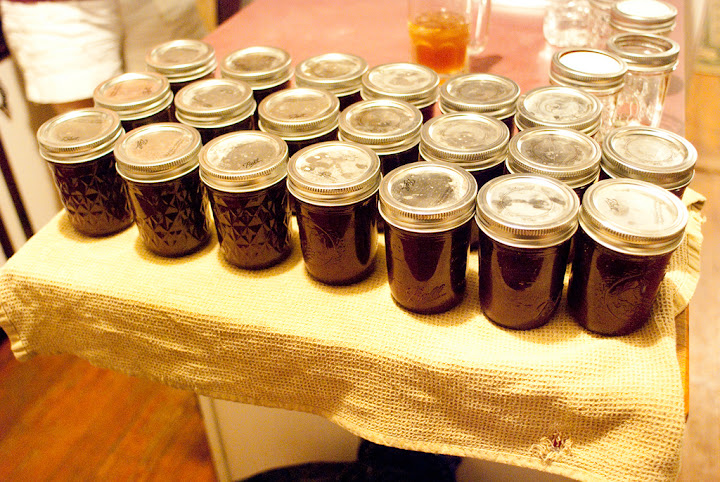
The results of our efforts!
Over all I think our foray into grape processing went very well and was a lot of fun. We will update on the progress with house construction very soon!
-k. vincent
August 5th, 2010 at 8:40 pm
wine AND jelly? very impressive. I also like the tribute to A&M during your wine fermentation…
Mustang grapes, do those only grow in a particular climate? could you possible describe their flavor? as well, what food chemistry facts for a ‘notoriously acidic’ grape affect the wine making process?
August 7th, 2010 at 10:20 am
Mustang grapes (Vitis mustangensis) are a species of wild/adapted grape thats most common to the Texas, Oklahoma, Louisiana, Alabama etc areas. There are other grapes that are similar like Muscadine and Fox grapes that may grow in other parts.
Flavor wise they have an earthy/slightly nutty taste and raw they are extremely sour. The insides have a semi gelatinous layer that contains the seeds. As far as wine making, the acid has to be corrected by dilution with water and/or alkaline compounds. The skins have a lot of flavor/tannins which is why we decided to macerate everything for a bit longer to give us some flavor depth (hopefully not too much). The lack of sugar in the grape doesn’t allow for enough material to create 10% alcohol by weight, the minimum needed for bottle storage. That is why sugar needs to be added. The secondary fermentation (malolactic) and aging (1-4 years) will also help tame the wine and give it a smoother taste.
February 28th, 2011 at 10:54 pm
[...] have commented on the wine making activities so I figured I would give an update! We last left off here in our grape stomping/primary fermenting stages. As some of you may know, wine making is very much [...]